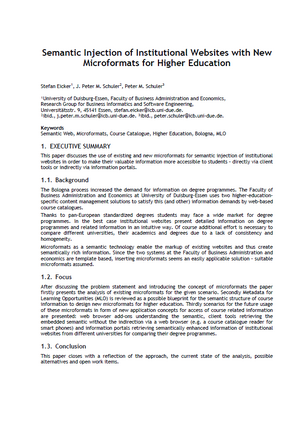Publikationen

Art der Publikation: Beitrag in Sammelwerk
Semantic Injection of Institutional Websites with New Microformats for Higher Education
- Autor(en):
- Eicker, Stefan; Schuler, J. Peter M.; Schuler, Peter M.
- Titel des Sammelbands:
- 15th International Conference of European University Information Systems (EUNIS 2009)
- Ort(e):
- Santiago de Compostela, Spain
- Veröffentlichung:
- 2009
- Sprache:
- english
- Schlagworte:
- Semantic Web, Microformats, Course Catalogue, Higher Education, Bologna, MLO
- Volltext:
- <a href="/fileadmin/migratedchairt3assets/file/p116_1__05.pdf" class="pdf">Semantic Injection of Institutional Websites with New Microformats for Higher Education (123 KB)</a>
- Zitation:
- Download BibTeX
Kurzfassung
1. EXECUTIVE SUMMARY
This paper discusses the use of existing and new microformats for semantic injection of institutional websites in order to make their valuable information more accessible to students – directly via client tools or indirectly via information portals.
1.1. Background
The Bologna process increased the demand for information on degree programmes. The Faculty of Business Administration and Economics at University of Duisburg-Essen uses two higher-educationspecific content management solutions to satisfy this (and other) information demands by web-based course catalogues.
Thanks to pan-European standardized degrees students may face a wide market for degree programmes. In the best case institutional websites present detailed information on degree programmes and related information in an intuitive way. Of course additional effort is necessary to compare different universities, their academics and degrees due to a lack of consistency and homogeneity.
Microformats as a semantic technology enable the markup of existing websites and thus create semantically rich information. Since the two systems at the Faculty of Business Administration and economics are template based, inserting microformats seems an easily applicable solution – suitable microformats assumed.
1.2. Focus
After discussing the problem statement and introducing the concept of microformats the paper firstly presents the analysis of existing microformats for the given scenario. Secondly Metadata for Learning Opportunities (MLO) is reviewed as a possible blueprint for the semantic structure of course information to design new microformats for higher education. Thirdly scenarios for the future usage of these microformats in form of new application concepts for access of course related information are presented: web browser add-ons understanding the semantic, client tools retrieving the embedded semantic without the indirection via a web browser (e.g. a course catalogue reader for smart phones) and information portals retrieving semantically enhanced information of institutional websites from different universities for comparing their degree programmes.
1.3. Conclusion
This paper closes with a reflection of the approach, the current state of the analysis, possible alternatives and open work items.<span id="1252314128046S"> <span id="1252314278278S"> </span>
</span>
